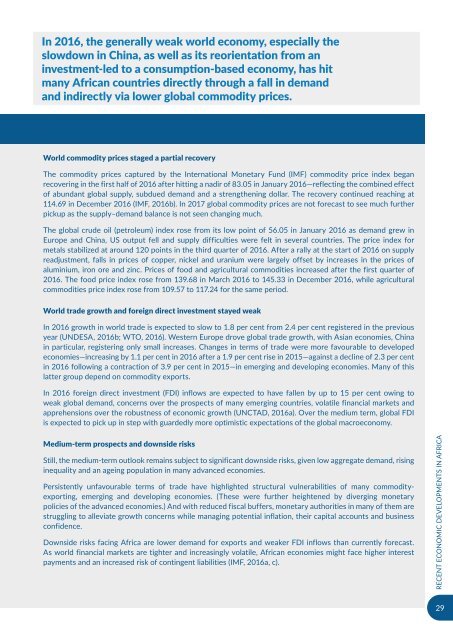URBANIZATION AND INDUSTRIALIZATION
Economic%20Report%20on%20Africa%202017%20UNECA
Economic%20Report%20on%20Africa%202017%20UNECA
You also want an ePaper? Increase the reach of your titles
YUMPU automatically turns print PDFs into web optimized ePapers that Google loves.
In 2016, the generally weak world economy, especially the<br />
slowdown in China, as well as its reorientation from an<br />
investment-led to a consumption-based economy, has hit<br />
many African countries directly through a fall in demand<br />
and indirectly via lower global commodity prices.<br />
World commodity prices staged a partial recovery<br />
The commodity prices captured by the International Monetary Fund (IMF) commodity price index began<br />
recovering in the first half of 2016 after hitting a nadir of 83.05 in January 2016—reflecting the combined effect<br />
of abundant global supply, subdued demand and a strengthening dollar. The recovery continued reaching at<br />
114.69 in December 2016 (IMF, 2016b). In 2017 global commodity prices are not forecast to see much further<br />
pickup as the supply–demand balance is not seen changing much.<br />
The global crude oil (petroleum) index rose from its low point of 56.05 in January 2016 as demand grew in<br />
Europe and China, US output fell and supply difficulties were felt in several countries. The price index for<br />
metals stabilized at around 120 points in the third quarter of 2016. After a rally at the start of 2016 on supply<br />
readjustment, falls in prices of copper, nickel and uranium were largely offset by increases in the prices of<br />
aluminium, iron ore and zinc. Prices of food and agricultural commodities increased after the first quarter of<br />
2016. The food price index rose from 139.68 in March 2016 to 145.33 in December 2016, while agricultural<br />
commodities price index rose from 109.57 to 117.24 for the same period.<br />
World trade growth and foreign direct investment stayed weak<br />
In 2016 growth in world trade is expected to slow to 1.8 per cent from 2.4 per cent registered in the previous<br />
year (UNDESA, 2016b; WTO, 2016). Western Europe drove global trade growth, with Asian economies, China<br />
in particular, registering only small increases. Changes in terms of trade were more favourable to developed<br />
economies—increasing by 1.1 per cent in 2016 after a 1.9 per cent rise in 2015—against a decline of 2.3 per cent<br />
in 2016 following a contraction of 3.9 per cent in 2015—in emerging and developing economies. Many of this<br />
latter group depend on commodity exports.<br />
In 2016 foreign direct investment (FDI) inflows are expected to have fallen by up to 15 per cent owing to<br />
weak global demand, concerns over the prospects of many emerging countries, volatile financial markets and<br />
apprehensions over the robustness of economic growth (UNCTAD, 2016a). Over the medium term, global FDI<br />
is expected to pick up in step with guardedly more optimistic expectations of the global macroeconomy.<br />
Medium-term prospects and downside risks<br />
Still, the medium-term outlook remains subject to significant downside risks, given low aggregate demand, rising<br />
inequality and an ageing population in many advanced economies.<br />
Persistently unfavourable terms of trade have highlighted structural vulnerabilities of many commodityexporting,<br />
emerging and developing economies. (These were further heightened by diverging monetary<br />
policies of the advanced economies.) And with reduced fiscal buffers, monetary authorities in many of them are<br />
struggling to alleviate growth concerns while managing potential inflation, their capital accounts and business<br />
confidence.<br />
Downside risks facing Africa are lower demand for exports and weaker FDI inflows than currently forecast.<br />
As world financial markets are tighter and increasingly volatile, African economies might face higher interest<br />
payments and an increased risk of contingent liabilities (IMF, 2016a, c).<br />
RECENT ECONOMIC DEVELOPMENTS IN AFRICA<br />
29


